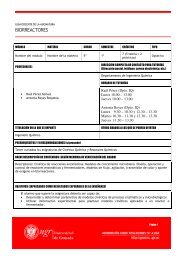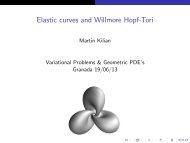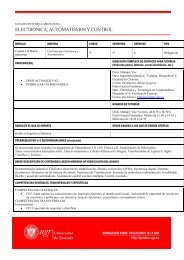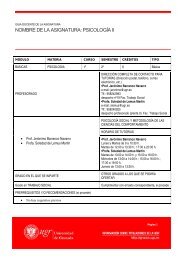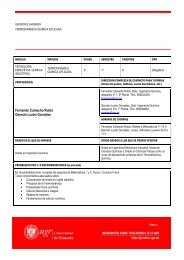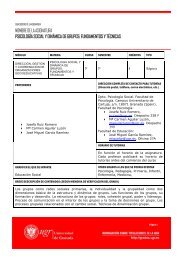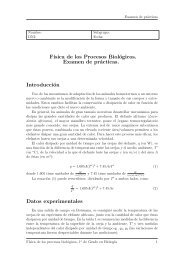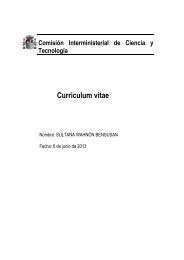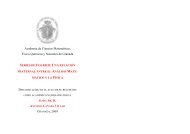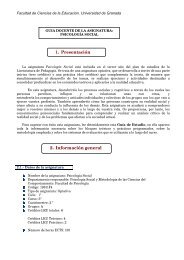1.5 Aquatic Macroinvertebrates
1.5 Aquatic Macroinvertebrates
1.5 Aquatic Macroinvertebrates
You also want an ePaper? Increase the reach of your titles
YUMPU automatically turns print PDFs into web optimized ePapers that Google loves.
<strong>1.5</strong><strong>Aquatic</strong> <strong>Macroinvertebrates</strong>Javier Alba-Tercedor<strong>1.5</strong>.1 Introduction<strong>1.5</strong>.2 Macroinvertebrate Groups<strong>1.5</strong>.3 Adaptations to Survive in a Flowing Habitat<strong>1.5</strong>.3.1 Flattening of the body<strong>1.5</strong>.3.2 Streamlining (hydrodynamic shapes)<strong>1.5</strong>.3.3 Reduction of projecting structures<strong>1.5</strong>.3.4 Fixative or anchorage structuresSuckersHooksIncreasing the weight (ballasting)Friction-pads and marginal contact<strong>1.5</strong>.3.5 Small size<strong>1.5</strong>.4 The Drift<strong>1.5</strong>.5 Respiratory Mechanisms<strong>1.5</strong>.6 Feeding Mechanisms and Role in <strong>Aquatic</strong> Lotic Systems<strong>1.5</strong>.7 <strong>Macroinvertebrates</strong> and PollutionReferences<strong>1.5</strong>.1 INTRODUCTIONThe term ‘macroinvertebrate’ does not respond to a taxonomical concept but to anartificial delimitation of part of the groups of invertebrate animals. In running waters,we generally consider as macroinvertebrates those organisms large enough to be ableBiological Monitoring of Rivers Edited by G. Ziglio, M. Siligardi and G. FlaimC○ 2006 John Wiley & Sons, Ltd.71
72 <strong>Aquatic</strong> <strong>Macroinvertebrates</strong>to be caught with a mesh size of 250 µm, and thus observed at first sight. In fact,most of them are larger than 1 mm in size.Despite the general definition given above, some animal groups that could fit init are never considered as macroinvertebrates (i.e. Protozoa and Tardigrada), whileother groups (i.e. Nematoda, Nematomorpha, Cladocera, Copepoda, etc.) are nottaken into account by methodologies based on macroinvertebrates.At the beginning of this century, Kolwitz and Marsson (1902) clearly formulatedthe relationship of aquatic organisms to the purity and pollution of water. Since then,many methods to assess biological water quality, using different organisms (virus,bacteria, fungi, lichens, algae, plants, protozoa, macroinvertebrates and fishes) havebeen performed. However, most of the methodologies are based on macroinvertebrates(Hellawell, 1986; De Pauw et al.,1992; Rosenberg and Resh, 1993; Ghetti,1997).<strong>1.5</strong>.2 MACROINVERTEBRATE GROUPSMost of the macroinvertebrate groups (Table <strong>1.5</strong>.1) are arthropods, and the insectsrepresent the great majority (Figure <strong>1.5</strong>.1). To identify these groups, thereare several general texts permitting identification, at least to the family, and in manycases to the generic level. Thus, for instance, for the European fauna there aregeneral publications written in different languages, i.e. Catalan (Puig et al., 1999),French (Tachet et al., 2000), Italian (Campaioli et al., 1994; Sansoni, 1988), Danish(Dall and Lingegaard, 1995), Dutch (De Pauw and Vannevel, 1990), English (Fitterand Manuel, 1986; De Pauw et al., 1996; Puig et al., 1999) and Spanish (Puig etal., 1999). There exist many publications dedicated to each particular group andnumerous websites are now appearing all over the world, hence permitting easyTable <strong>1.5</strong>.1Most common groups of benthic macroinvertebratesArthropodsInsectaPlecopteraEphemeropteraTrichopteraOdonataHeteropteraColeopteraMegalopteraDipteraNon-arthropodsTurbellariaMolluscaOligochaetaHirudineaCrustaceaAmphipodaIsopodaDecapoda
Adaptations to Survive in a Flowing Habitat 77Figure <strong>1.5</strong>.6(b) dorsalViews ofthe common mollusc gastropod species Ancylus fluviatilis: (a) ventral;structures (Figure <strong>1.5</strong>.7), while some nymphs of mayflies (i.e. Serratella ignita) andstoneflies (i.e. Taenyopteryx sp.) (Figure. <strong>1.5</strong>.7) have dorsal abdominal spines, thushelping them to anchor to the vegetation.Sometimes, i.e. larvae of caddisflies, simulids and chironomids, secrete silk thathelps to attach the individuals to the substrate, so enhancing at the same time the useof the hook structures.(a) (b) (c) (d)Figure <strong>1.5</strong>.7 (a) Larva and pupa of Limnophora (Diptera), (b) larva of Simuliidae (Diptera),(c) nymph of Serratella ignite (Ephemeroptera) and (d) latero-abdominal view of the nymphs ofTaeniopteryx sp. (Plecoptera)
Adaptations to Survive in a Flowing Habitat 73GenilInsecta89.3 %Hirudinea 1.3 %Turbellaria 1.3 %Oligochaeta 1.7 %Crustacea 2.6 %Mollusca 3.8 %GuadalquivirInsecta75.3 %Turbellaria 1.3 %Crustacea 1.3 %Hirudinea 3.9 %Oligochaeta 5.2 %GuadalfeoInsecta78.1 %Oligochaeta 4.7 %Turbellaria 1.6 %Mollusca 10.9 %G. MenorMollusca 13.0 %AdraInsecta77.8 %Hidracarina 1.6 %Crustacea 3.1 %Oligochaeta 4.9 %Turbellaria 2.5 %Insecta75.3 %Turbellaria 1.3 %Crustacea 1.3 %Hirudinea 3.9 %Oligochaeta 5.2 %Mollusca 9.9 %Hidracarina 1.2 %Crustacea 3.7 %Mollusca 13.0 %Figure <strong>1.5</strong>.1Macroinvertebrate compositions in different rivers in southern Spainidentification to family or genus level. However, an identification to the specieslevel is more complex, requiring an interaction with taxonomists, and in many casesit is not possible to identify the immature aquatic forms, simply because they areunknown.<strong>1.5</strong>.3 ADAPTATIONS TO SURVIVE INA FLOWING HABITATWater current is the most important characteristic of running waters. Thus, aquaticmacroinvertebrates have needed to develop anatomical and behavioral strategies inorder to survive in this ecosystem to avoid being swept away.According to Hynes (1970), the most common anatomical adaptations can besummarized as follows.<strong>1.5</strong>.3.1 Flattening of the bodyIn running waters, the highest velocities are found at the surface and near to thecentre of the channel, where the friction is lower (in deep rivers, due to the frictionwith the atmosphere current the speed is highest just below the surface). The velocitydecreases, from the surface to the bottom as a function of the logarithm of the depth
74 <strong>Aquatic</strong> <strong>Macroinvertebrates</strong>Water surface0Units of total depth0.60.6 × depthMean velocityBoundary layer1.00Units of velocity50Figure <strong>1.5</strong>.2 Decrease of current speed with depth (adapted from Hynes, 1970)(Figure <strong>1.5</strong>.2), and there is a boundary layer right on the bed in which it declinesvery rapidly to zero (Hynes, 1970; Allan, 1995).Some animals develop their activities in stony substrata and are flattened to be ableto pass through the narrow pathways existing between pebbles and stones. Moreover,others, such as mayflies of the genera Rhithrogena, Ecdyonurus or Epeorus, feedwhile on the stones, and thus they would be exposed to the possibility of being sweptaway. However, they have solved this problem by developing flat enough bodieswhich allow them to live in the relative still boundary layer (Figure <strong>1.5</strong>.3).<strong>1.5</strong>.3.2 Streamlining (hydrodynamic shapes)The advantages of a hydrodynamic shape, which decreases the resistance to thewater, are well known in fishes, and one might expect it to be common among streaminhabitants. However, it is rather rare and almost the only animals that display it toperfection are the baetid mayflies (Figure <strong>1.5</strong>.4).<strong>1.5</strong>.3.3 Reduction of projecting structuresIn general, projecting structures increase the resistance to the current and animalsliving in the current, where such structures are at risk of being swept away. Therefore,
Adaptations to Survive in a Flowing Habitat 75(a)(b)Figure <strong>1.5</strong>.3 Flattening of the body in genera of mayflies of the family Heptageniidae: (a)Rhithrogena; (b) Epeorus. Reproduced by permission of the Blackburn Press from Hynes, H. B.N., 1979, The Ecology of Running Waters, Liverpool University Press, Liverpool, UK(a)(b)(c)Figure <strong>1.5</strong>.4muticusMayflies of the family Baetidae: (a) Baetis maurus; (b) Rhodani; (c) Allainites
76 <strong>Aquatic</strong> <strong>Macroinvertebrates</strong>what has been observed in some animals seems logical. For instance, some mayflies,such as Epeorus or some species of Baetis, typical inhabitants of high velocitieszones, reduce the terminal filament (Figure. <strong>1.5</strong>.4).<strong>1.5</strong>.3.4 Fixative or anchorage structuresSuckersTrue hydraulic suckers can be found in leeches (Hirudinea) and in Diptera of thefamily Blephariceridae (Figure <strong>1.5</strong>.5).From a functional point of view, the broad feet of the gastropod molluscs are quitesimilar to suckers; in fact, the limpet-like Ancylidae are very characteristic of stonysubstrata (Figure <strong>1.5</strong>.6), which support strong current velocities.HooksMost of the stream-inhabitant arthropods present well-developed tarsal claws, hencepermitting them to hold on to the ‘roughnesses’ on stone surfaces. Trichopteranlarvae present conspicuous posterior claws. Circles of hooks help to fix the animals,and can be found, for instance, on the prolegs on some dipteran families, as inthe case of the Blephariceridae (see Figure <strong>1.5</strong>.5) and at the base of the body ofthe Simuliidae (Figure <strong>1.5</strong>.7). Some pupae shown hook-attaching structures, forinstance, the dipteran Limnophora shows posterior prolegs transformed in to hookFigure <strong>1.5</strong>.5 Views ofalarva of Blephariceridae (Diptera), showing the characteristic ventralsuckers which permit it to live in currents with high velocities
78 <strong>Aquatic</strong> <strong>Macroinvertebrates</strong>(a)(b)Figure <strong>1.5</strong>.8Caddisflies: (a) Sericostomatidae; (b) cases of the family GoeridaeIncreasing the weight (ballasting)Many caddisflies build their cases with large-sized sand grains (‘little stones’) thatmake them heavier and difficult to be swept out, while the Goeridae include additional‘large’ pieces of sand (Figure <strong>1.5</strong>.8).Among the mollusks, it is also noticeable that running-water species of the familyUnionidae (Anodonta sp., Unio sp.) are often massive, as opposed to still-waterforms (Figure <strong>1.5</strong>.9).Friction-pads and marginal contactIn many insects, the flattened ventral surface, or some structure around the edgeof the animal, helps to maintain the body in close contact with the substratum, soincreasing the frictional resistance and thus avoiding the possibility that the animalbe dragged out by the current. In this sense, the soft flexible periostracum of theAncylidae (see Figure. <strong>1.5</strong>.6) fits closely to the irregularities of the surface of thesubstratum: the larvae of the beetles of the genus Elmis are flattened and have aperipheral complex of bristles which fit the surface and seal off the ventral side ofthe larva (Figure <strong>1.5</strong>.10).The ventral gills of nymphs of some heptagenid genera of mayflies (Rhithrogenaand Epeorus) are disposed, forming a ventral ring in contact with the substratum,hence increasing the area of marginal contact and reducing the possibility that waterflows under the animals (Figure <strong>1.5</strong>.11).(a)(b)Figure <strong>1.5</strong>.9Bilvalvia molluscs of the family Unionidae: (a) Anodonta sp.; (b) Unio sp.
Adaptations to Survive in a Flowing Habitat 79Figure <strong>1.5</strong>.10Larva of a beetle of the family Elmidae (Elmis)Among the molluscs, it is also noticeable that running water species of the familyUnionidae (Anodonta, Unio and Margaritifera) are often massive, as opposed tostill-water forms.<strong>1.5</strong>.3.5 Small sizeIt is clear that animals with small body size can inhabit the boundary layer, thusavoiding being dragged out. In this sense, we can find examples within the firstinstars of many insects, e.g. beetles of the family Elmidae (Figures <strong>1.5</strong>.10 and <strong>1.5</strong>.12),Hydracarina, etc.(a)(b)(c)Figure <strong>1.5</strong>.11 Mayflies of the genera Rhithrogena (a, b) and Epeorus (c), where (b) and (c) areventral views showing the friction pads formed by the abdominal gills
80 <strong>Aquatic</strong> <strong>Macroinvertebrates</strong>Figure <strong>1.5</strong>.12(a) Larva and (b) adult of an elmid Coleoptera of the genus Riolus<strong>1.5</strong>.4 THE DRIFTDespite their adaptations, stream-dwelling animals have high probabilities of beingdragged out by the current when they are moving. The phenomenon of being sweptdown stream is known as ‘drift’. There is a ‘normal’ daily drift that affects quitea large number of organisms, according to a circadian rhythm, and this generallyincreases during the night (Figure <strong>1.5</strong>.13) (see Hynes, 1970 (in Allan, 1995)).Different stress situations (floods, drought, pollution, etc.) produce ‘catastrophic’drifts and in fact this phenomenon can be used to measure disturbances.To compensate the drift, in many macroinvertebrate a positive rheotaxis has beenobserved, and thus they trend to move upstream. These movements may occur justby swimming or walking, and in insects the compensation upstream flights of adults(Figure <strong>1.5</strong>.14), especially females, has been pointed out and evaluated by manyauthors (Müller, 1982; Hubbard, 1991).The drift and its consequences have a very important role in recolonization(Williams and Hynes, 1976), and as a consequence, in recuperating the fauna ofaltered stretches of river and streams.<strong>1.5</strong>.5 RESPIRATORY MECHANISMSMost aquatic macroinvertebrates conduct gaseous interchange through the tegument(cutaneous respiration). Many small instars and small-sized groups also maintainthis respiratory mechanism. Relatively large animals, which do not develop anyrespiratory systems however, need to inhabit very well oxygenated flowing waters(i.e. some gill-lacking larvae of Trichoptera or Plecoptera). Some groups, such as‘bloodwoms’ (Chironomidae), Notonectidae or Oligochaeta (Figure <strong>1.5</strong>.15), have arespiratory pigment (haemoglobin) that increases the efficiency to capture oxygen.Thus, these are very abundant downstream of organically polluted sites.
Respiratory Mechanisms 81SS SR2000Number of animals15001000SS SRSS SR500012 22 2 6 1 19 23 1 6 10 14 22 24Time (h)Figure <strong>1.5</strong>.13 Drift activity of mayflies of the genus Baetis during artificially shortened nights(SS and SR correspond to natural sunset and sunrise, respectively), although artificial lights reducedthe period of darkness to 4, 2 and 1 h, respectively (adapted from Müller, 1965 (in Allan, 1995))Figure <strong>1.5</strong>.14 Compensation flights of two mayflies (adapted from Müller, 1982)
82 <strong>Aquatic</strong> <strong>Macroinvertebrates</strong>(a)(b)Figure <strong>1.5</strong>.15(a) Oligochaeta and (b) larva of ChironomidaeMost macroinvertebrates develop gills – tracheal gills in the case of insects. Theanimals trend to ventilate the body and/or gills by different methods (Merrit andCummins, 1996): by undulation (i.e. Chironomidae, Trichoptera, Lepidoptera),swimming, or just positioning themselves in water-flowing areas (i.e. Plecoptera,Ephemeroptera, Zygoptera, Trichoptera, Simuliidae, Blephariceridae); beating thegills (Ephemeroptera), or by contractions of the legs which move the body up anddown (Plecoptera, Zygoptera, Lestidae).Insects have colonized aquatic habitats once they had developed a terrestrial trachealrespiratory system, a system with external spiracles. To be able to use thissystem in water, they have transformed the existing structures by reducing the externalspiracles: totally (cutaneous respiration, or developing tracheal gills) or partially(at the end of the body). In the case that some spiracles remain, the animal maydirectly breathe atmospheric air. However, in a flowing habitat, reaching the surfacemay be quite risky. This is why many animals retain air bubbles, diminishing thefrequency of displacements to the surface by using the bubbles as artificial-gasesinterchangedevices. However, spherical air bubbles tend to increase their content innitrogen, so inducing the animal to go to the surface to renew the bubble. However,thinner and flat bubbles (plastron), such as those existing in the bug Apheilocheirusor in some Elmidae beetles, don’t have that problem and permit the animal to divepermanently without the risk of reaching for the surface.There are some insects, considered as ‘plant breathers’ (Coleoptera, Chrysomelidae,Curculionidae/Diptera, Culicidae, Ephydridae, Syrphidae), which when fixedto macrophytes can obtain oxygen directly from the plant.In the case of oxygen decline induced by organic pollution, those animals that arenot dependent on oxygen dissolved in water will be lesser affected, and thus moretolerant.
<strong>Macroinvertebrates</strong> and Pollution 83<strong>1.5</strong>.6 FEEDING MECHANISMS AND ROLEIN AQUATIC LOTIC SYSTEMSTo characterize what macroinvertebrates eat, analysis of the gut contents is normallycarried out. With these methods, it is usually difficult to decide if a particular animalis a herbivore, a detritivore, or just a unspecific eater of small particles. This is anexample of why it has been decided to distinguish functional food guilds on the basisof how the food is obtained, instead of what food is eaten (Cummins, 1973). Thus,different categories are distinguished (see Table <strong>1.5</strong>.2).<strong>Aquatic</strong> macroinvertebrates are important links within the lotic food web, playinga central role in the decomposition and processing of organic matter inputs, and inthe processing of nutrients (Merrit et al., 1984). According to the ‘River ContinuumConcept’ (Vannote et al., 1980), large particle shredders are common in headwaterswhere most energy is derived from coarse particulate organic matter (CPOM) (i.e.>1 mm, for example, leaves, twigs, wood) which enters from the adjacent watershed,but become rare in higher-order streams since organic matter is reduced to afiner particle size, and periphyton becomes more important as a food source (Figure<strong>1.5</strong>.16). These biological processes, combined with physical abrasion, reducethe particle size of organic matter as it goes through the transport and storage process.Therefore, the particle size decreases as the stream order increases. Accordingto this concept, downstream communities in higher-order streams depend on theinefficiency of the upstream communities when they process the CPOM.<strong>1.5</strong>.7 MACROINVERTEBRATES AND POLLUTIONDifferent groups of macroinvertebrates have a different behaviour with respect toalterations, and thus lists of tolerant or non-tolerant species can be found (Hart andFuller, 1974; Hellawell, 1986; Rosenberg and Resh, 1993). In general, Stoneflies,Trichoptera, and Ephemeroptera are considered non-tolerant, while Tubificidae orred Chironomidae are considered tolerant. In fact, the beginning of the use ofmacroinvertebrates to assess water quality was based on the concept of indicatororganism, and still remains in some biomonitoring methods. However, this is a verysimplistic approach. For instance, it is true that, in general, mayflies are found ingood quality waters, and the number of nymph occurrences decrease in pollutedwaters (Figure. <strong>1.5</strong>.17). However, some species can inhabit clearly polluted waters(Alba-Tercedor et al., 1995). Thus, instead of using just the presence or absence ofan indicator organism, the concept has been broadened to include indicator communities(Rosenberg and Resh, 1996).According to Hellawell (1986), macroinvertebrates are suitable as bioindicatorsbecause of the following: (a) they constitute a heterogeneous assemblage of animalphyla and consequently it is probable that some members will respond to whateverstresses are placed upon them; (b) many are sedentary, which assists in detecting
84 <strong>Aquatic</strong> <strong>Macroinvertebrates</strong>Table <strong>1.5</strong>.2 Macroinvertebrate functional groups (adapted from Merritt and Cummins, 1996,and Allan, 1995)Functional group Food resource a,b Feeding mechanism a ExamplesShreddersCollectorsLiving vascularhydrophyte planttissueDecomposingvascular planttissue – CPOMWoodDecomposingFPOMScrapers (grazers) Periphytons –attached algae(especiallydiatoms)MacrophytepiercersPredatorsLiving vascularhydrophyte celland tissue fluidsor filamentous(macroscopic)algal cell fluidsLiving animaltissuea CPOM, coarse particulate organic matter.b FPOM, fine particulate organic matter.Herbivores – chewersand miners of livemacrophytesDetritivores – chewersof CPOMGougers – excavategalleries in woodDetritivores – filterersor suspensionfeedersDetritivores – gatheror deposit(sediment) feedersHerbivores – grazing.Scrapers of mineraland organicsurfacesHerbivores – piercetissues or cells andsuck fluidsEngulfers – carnivoresattack prey andingest wholeanimals or partsPierces – carnivoresattack prey, piercetissues and cells,and suck fluidsSome families ofTrichoptera,Plecoptera andCrustacea; someDiptera,EphemeropteraColeoptera and snailsOccasional taxa amongDiptera, Coleopteraand TrichopteraNet-spinningTricho-tera,Simuliidae and someEphemeropteraMany Ephemeroptera,Chironomidae andCeratopogonidaeSeveral families ofEphemeroptera andTrichoptera; someDiptera, Lepidopteraand ColeopteraNeuroptera and someTricoptera(Hydroptilidae)Some Hirudinea,Plecoptera,Odonata, Coleopteraand Diptera
<strong>Macroinvertebrates</strong> and Pollution 85(a) (b) (c)(d)(e)Figure <strong>1.5</strong>.16 (Plate 1) Examples of different mechanisms for detritivore-filters (collectors) byusing silk nets (a, b) and filter setae (c–e): Trichoptera Hydropsyche sp. lava (a) and net (b); headof a larva of Simuliidae, showing the filtering mandibular folding fans (c); Ephemeroptera of thefamily Oligoneuriidae showing the long filter bristles of the internal sides of the forelegs (d, e)1400Total number of frequencies1200100080060040020001 2 3 4 5Water quality classFigure <strong>1.5</strong>.17 Frequency of captures of the Ephemeroptera species for different water qualities(from very clean, 1, to very polluted, 5) in the Guadalquivir River basin (Southern Spain)
86 <strong>Aquatic</strong> <strong>Macroinvertebrates</strong>the precise location of pollutant sources, and some have relatively long life histories(measurable in years) and this provides both a facility for examining temporalchanges and also integrating the effect of prolonged exposure to intermittent dischargesor variable concentrations of pollutants. This also justifies the adoption ofperiodic sampling. Such a procedure would be invalid for groups having short lifehistories; (c) qualitative sampling of benthic macroinvertebrates is relatively easy,the methodology is well developed and equipment does not need to be elaborate;(d) taxonomic keys are available for most groups although certain ‘difficult” taxaexist; (e) perhaps the most useful feature of this group is that many methods ofdata analysis, including pollution indices and diversity indices, have been devised.Therefore the great majority of methodologies developed for biomonitoring watercourses are based on benthic macroinvertebrates.REFERENCESAlba-Tercedor, J., Picazo-Muñoz, J. and Zamora-Muñoz, C., 1995. ‘Relationships between thedistribution of mayfly nymphs and water quality in the Guadalquivir River basin (SouthernSpain)’. In:Current Research on Ephemeroptera, Corkum, L. D. and Ciborowski, J. J. H. (Eds).Canadian Scholar Press: Toronto, ON, Canada, pp. 41–54.Allan, J. D., 1995. Stream Ecology. Structure and Function of Running Waters. Chapman & Hall:London, UK.Campaioli, S., Ghetti, P. F., Minelli, A. and Ruffo, S., 1994. Manuali per il riconoscimento deimacroinvertebrati delle acque doci italiane, Vol. I. Agenzia Provinziale per la Protezione dellAmbiente: Provincia Autonoma di Trento, Trento, Italy.Cummins, K. W., 1973. ‘Trophic relations of aquatic insects’. Annual Review of Entomology, 18,183–206.Dall, P. C. and Lindergaard, C. (Eds), 1995. En oversigt over ferskvandsinvertebrater til brug vebedommelse af forureningen i soer og vandlob. Ferskvandsbiologisk Laboratorium, KobenhavnsUniversitet.De Pauw, N. and Vannevel, R., 1990. Macro-invertebraten en Waterkwaliteitk Stichting Leefmilien.State University of Ghent: Ghent, Belgium.De Pauw, N, Ghetti, P. F., Manzini, P. and Spaggiari, R., 1992. ‘Biological assessment methods forrunning water quality’. In: River Water Quality. Ecological Assessment and Control,Newman,P. J., Piavaux, P. A. and Sweeting, R. A. (Eds), EUR 14606 EN-FR. Commission of the EuropeanCommunities: Brussels, Belgium.De Pauw, N., van Damme, D. and Bij de Vaate, A., 1995. Manual for Macroinvertebrate Identificationand Water Quality Assessment, document intended for use in the ‘Integrated Programmefor Implementation of the Recommended Transnational Monitoring Strategy for the DanubeRiver Basin’, a CEC PHARE/TACIS Project. State University of Ghent: Ghent, Belgium.Fitter, R. and Manuel, R., 1986. A Collins Field Guide to the Freshwater Life of Britain andNorth-West Europe. William Collins: London, UK.Ghetti, P. F. 1997. Manuale di aplicazione indice biotico esteso (IBI). I macroinvertebrati nelcontrollo della qualitádegli ambienti di acque correnti. Agenzia Provinziale per la Protezionedell Ambiente: Provincia Autonoma di Trento, Trento, Italy.Hart, C. W. and Fuller, S. L. H., 1974. Pollution Ecology of Freshwater Invertebrates. AcademicPress: New York, NY, USA.
References 87Hellawell, J. M., 1986. Biological Indicators of Freshwater Pollution and Environmental Management.Elsevier: London, UK.Hubbard, M. D., 1991. ‘Theoretical and practical problems involved in determination of upstreamflight compensation in lotic aquatic insects’. In: Overview and Strategies of Ephemeroptera andPlecoptera, Alba-Tercedor, J. and Sánchez-Ortega, A. (Eds). Sandhill Crane Press: Gainesville,FL, USA, pp. 359–365.Hynes, H. B. N., 1970. The Ecology of Running Waters. Liverpool University Press: Liverpool,UK.Kolwitz, R. and Marsson, M., 1902. ‘Grundzätze für die biologische Beurteilung der Wassers nachseiner Flora und Fauna’. Prüfungsanst, Wasserversog, Abwasserreinig, 1, 33–72.Merrit, R. W. and Cummins, K. W. (Eds), 1996. An Introduction to the <strong>Aquatic</strong> Insects of NorthAmerica, 3rd Edition. Kendal/Hunt Publishing, Dubuque, Ia, USA.Merrit, R. W., Cummins, K. W. and Burton, T. M., 1984. ‘The role of aquatic insects in theprocessing and cycling of nutrients’. In: The Ecology of <strong>Aquatic</strong> Insects. Resh, V. H. andRosenberg, D. M. (Eds). Praeger: New York, NY, USA.Müller, K., 1982. ‘The colonization cycle of freshwater insects’. Oecologia, 52, 202–207.Puig, M. A., Benito, G., Ferreras, M., Romero, J., Garcia-Aviles, J. and Soler, G., 1999. ‘Elsmacroinvertebrats dels rius catalans’. Departament de Medi Ambient, Generalitat de Catalunya:Barcelona, Spain (in Catalan, with Spanish and English translations).Rosenberg, D. M. and Resh, V. H. (Eds), 1993. Freshwater Biomonitoring and Benthic <strong>Macroinvertebrates</strong>.Chapman and Hall: New York, NY, USA.Rosenberg, D. M. and Resh, V. H., 1996. ‘Use of aquatic insects in biomonitoring’. In: An Introductionto the <strong>Aquatic</strong> Insects of North America, 3rd Edition, Merrit, R. W. and Cummins,K. W. (Eds). Kendall/Hunt Publishing: Dubuque, Ia, USA.Sansoni, G., 1988. ‘Atlante per il riconoscimento dei macroinvertebrati dei corsi d’acqua italiane’.Centro italiano di Biologia Ambientale: Provincia Autonoma di Trento, Trento, Italy.Tachet, H., Richoux, P., Bournaud, M. and Usseglio-Polatera, P., 2000. Invertébrés d’Eau Douce.Systématique, Biologie, Écologie. CNRS Editions: Paris, France.Vannotte, R. L., Minshall, G. W., Cummins, K. W., Sedell, J. R. and Cushing, C. E., 1980. ‘Theriver continuum concept’. Canadian Journal of Fisheries and <strong>Aquatic</strong> Science, 37, 130–137.Williams, D. D. and Hynes, H. B. N., 1976. ‘The recolonization mechanisms of stream benthos’.Oikos, 27, 265–272.



